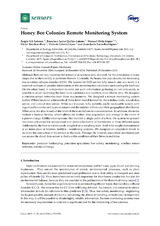Honey Bee Colonies Remote Monitoring System
Autor
Gil-Lebrero, Sergio
Quiles-Latorre, Francisco Javier
Ortiz-López, Manuel
Sánchez-Ruiz, Víctor
Gámiz-López, Victoria
Luna Rodríguez, J.J.
Editor
MDPIFecha
2017Materia
Precision beekeepingPrecision apiculture
Bee colony monitoring
Wireless sensor network (WSN)
Internet of things
METS:
Mostrar el registro METSPREMIS:
Mostrar el registro PREMISMetadatos
Mostrar el registro completo del ítemResumen
Bees are very important for terrestrial ecosystems and, above all, for the subsistence of many
crops, due to their ability to pollinate flowers. Currently, the honey bee populations are decreasing
due to colony collapse disorder (CCD). The reasons for CCD are not fully known, and as a result, it is
essential to obtain all possible information on the environmental conditions surrounding the beehives.
On the other hand, it is important to carry out such information gathering as non-intrusively as
possible to avoid modifying the bees’ work conditions and to obtain more reliable data. We designed
a wireless-sensor networks meet these requirements. We designed a remote monitoring system
(called WBee) based on a hierarchical three-level model formed by the wireless node, a local data
server, and a cloud data server. WBee is a low-cost, fully scalable, easily deployable system with
regard to the number and types of sensors and the number of hives and their geographical distribution.
WBee saves the data in each of the levels if there are failures in communication. In addition, the nodes
include a backup battery, which allows for further data acquisition and storage in the event of
a power outage. Unlike other systems that monitor a single point of a hive, the system we present
monitors and stores the temperature and relative humidity of the beehive in three different spots.
Additionally, the hive is continuously weighed on a weighing scale. Real-time weight measurement
is an innovation in wireless beehive—monitoring systems. We designed an adaptation board to
facilitate the connection of the sensors to the node. Through the Internet, researchers and beekeepers
can access the cloud data server to find out the condition of their hives in real time.

